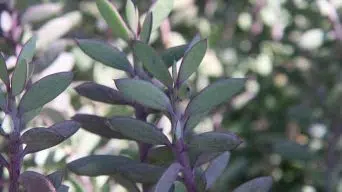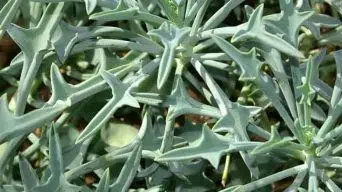Succulents are pretty common houseplants, but even so, there are always some specific species that become more popular over time.
The Senecio stapeliiformis succulent plant is just one of those plants which have recently gained some attention due to their unique appearance and easy-going care requirements.
This article aims to provide a complete guide on how to take care of and propagate the Senecio stapeliiformis succulent plant.
So, if you are one of the many people who have recently become interested in this succulent, read on for more information.
Overview
Senecio stapeliiformis, also known as Kleinia stapeliiformis, is a perennial succulent plant from the Asteraceae family that is native to South Africa.
The stems of this succulent species are leaned and erect, branching out from the base of the rhizome.
The purple-green cylindrical stems of this Senecio species have soft spines along the edges.
These soft and fleshy stems may reach a length of up to 10 inches (25 cm) and a diameter of up to 0.8 inches (2 cm), and branch out from the base of the rhizome.
The Senecio stapeliiformis blooms with beautiful large red or deep orange flowers.
Senecio stapeliiformis, besides being known as Kleinia stapeliiformis, is also commonly known by the following names:
- Pickle Plant
- Pickle Cactus
- Stapelia Stemmed Senecio
- Stapelioid Kleinia
- Trailing Jade
- Spider Plant
- Inch Worm Plant
- Candle Stick
- Candle Plant
How To Care for Senecio Stapeliiformis (Pickle Plant)
Senecio stapeliiformis care is not difficult, but it does require you to pay attention to the right conditions.
The following are the most crucial facts about caring for Senecio stapeliiformis.
Sun Exposure & Light Requirements
Senecio stapeliiformis thrives in full sun, but can also handle partial shade.
In order to ensure your plant is getting the right light exposure, place it in a spot where it will receive at least 4-5 hours of direct sunlight per day.
However, make sure it is protected from the hot afternoon sun in summer.
When grown indoors, place your Senecio stapeliiformis near a west or east-facing window, where it will receive plenty of morning or afternoon sun.
Outdoors, the Pickle Plant can be placed in a spot that receives no less than 4-5 hours of direct sunlight per day and in an area that has some protection from the hot afternoon sun.
Watering Requirements
Senecio stapeliiformis succulent plants should be watered sparingly. In fact, the soil should be allowed to dry out completely between waterings.
Overwatering succulents can quickly lead to root rot, so it is important to be attentive to the plant’s watering needs.
Don’t let the plant sit in water for long periods of time; it is always best to water thoroughly and then allow the potting medium to dry out entirely between subsequent waterings.
For indoor cultivation, it is generally recommended that you use no more than one-third the amount of water required for outdoor growing.
This will reduce the incidence of root rot problems experienced with outdoor plants.
Soil Requirements
Senecio stapeliiformis succulent plant thrives best in porous, well-draining soil. A cactus potting mix works well for this succulent plant.
If you do not have a cactus potting mix readily available, a mixture of sand, perlite, and soil can be used as well.
The best sand to use is coarse sand. Coarse sand allows for good porosity, which helps with drainage and prevents root rot from occurring.
Perlite aids in aeration and helps with drainage.
A mixture of perlite, soil, and coarse sand is a good choice for this succulent plant’s potting mix.
Temperature and Humidity
Senecio stapeliiformis thrives in temperatures between 65 and 85 degrees Fahrenheit, with a relative humidity of 40 to 50 percent.
In order to maintain these conditions, place your Senecio stapeliiformis in an area that receives plenty of indirect light and has good air circulation.
When the nighttime temperature is below 50 degrees, protect your Senecio stapeliiformis from frost by placing it on a protected patio or bringing it indoors.
Also, they cannot tolerate high humidity levels, so avoid placing it in areas such as the bathroom or kitchen. They need a drier environment.
Fertilizing
Senecio stapeliiformis is not particularly nutrient demanding and will do fine without extra fertilizer. It’s possible to give it a little boost, though.
Since, especially during the growing season, this plant can grow quickly and set new roots within weeks, you can almost be certain to see an effect after fertilizing.
If you want to feed your succulents, wait until the soil is dry to the touch so that the plant will take up any nutrients added and won’t just settle on top of the soil.
Feeding may be done with a balanced liquid fertilizer diluted to half-strength, avoiding contact with the leaves.
Also, avoid fertilizing when the plant is in full sunlight. This will avoid possible damage to the leaves by salt burn.
Potting and Repotting
Senecio stapeliiformis plants do not like to be root-bound, so it is important to pot them in a container that is only slightly larger than the current pot.
When the plant gets too big for its pot, it will start to grow leggy and produce fewer flowers. At this point, it is time to repot the plant into a slightly larger container.
When potting or repotting Senecio stapeliiformis succulents, be sure to use a container with a drainage hole.
One must be made if the container does not have a drainage hole. This is an essential step to keeping Senecio stapeliiformis succulents healthy and happy.
When repotting, be very gentle with the root system. Gently remove the plant from its pot and loosen the roots before putting it in its new pot.
Firm the soil around the roots, and don’t water the plant for a few days to allow the ground to settle.
Pruning
Senecio stapeliiformis plants don’t need much pruning.
In fact, you should only prune them if they are growing out of control or remove damaged and dead stems and flowers.
Removing damaged and dead stems can help your plant stay healthier.
Just be careful not to remove any healthy stems, as this will result in a limp and unattractive plant.
If the Senecio stapeliiformis plant is growing out of control, prune it to the desired size.
Depending on your preference, you can use pruning shears or a gardening knife.
When you are removing healthy stems or flowers, you should sterilize your cutting utensils with rubbing alcohol before using them to prevent infection of any diseases that are living on the tools.
If you need to prune your plant, only do so in the spring or early summer.
Pests and Diseases
Senecio stapeliiformis succulents are relatively hardy plants that don’t suffer from many pests or diseases.
However, mealybugs and scale insects can sometimes be a problem. Also, fungal diseases such as powdery mildew can occasionally affect these plants.
Mealybugs
Mealybugs are small, white insects that are covered in a fluffy wax secretion.
They suck the sap out of leaves and stems, damaging the plant tissues.
Mealybugs can be easily identified by their location, as they typically form dense clusters around the succulent stem areas of the Senecio stapeliiformis.
Scale Insects
Similar to mealybugs, scale insects are sap-feeding insects that form dense clusters around the stems of Senecio stapeliiformis succulents.
However, unlike mealybugs, they do not have a fluffy secretion coating; instead, they appear as small bumps on the leaves and stems.
Fungal Diseases
Powdery mildew is a fungal disease that affects many plants, including Senecio stapeliiformis succulents.
This disease causes a powdery white coating on the plant’s leaves and stems. The coating can eventually lead to leaf and stem dieback.
Powdery mildew can be identified by its location, as it typically forms a powdery coating over the leaf and stem areas of Senecio stapeliiformis succulents.
How to Care for Senecio Stapeliiformis (Pickle Plant) in Winter
Senecio stapeliiformis care in winter mainly consists of protecting the plant from low temperatures and prolonged periods of darkness, such as short days and freezing temperatures.
During the winter months, keeping the temperature around the plant above 10 degrees Celsius (50 degrees Fahrenheit) is highly recommended.
This can be done by placing the succulent near a window with plenty of sunlight, using a grow light, or placing it in a warm room.
If your Pickle Plant is outdoors, you need to bring it into a greenhouse or any other enclosed space if temperatures fall below 10 degrees Celsius.
It is also important to avoid exposing the succulents to direct cold winds and to make sure that the potting soil does not freeze.
If the soil is allowed to freeze, it will most likely kill the plant. If this happens and you still want to save your succulents, you should wait for the soil to thaw before watering it again (if it has not dried out too much).
In addition to keeping the plant warm, you should also provide plenty of light. Senecio stapeliiformis needs at least 4-5 hours of direct sunlight per day.
You can supplement with artificial grow lights if you cannot provide enough natural sunlight.
How To Propagate Senecio Stapeliiformis (Pickle Plant)
Sencio stapeliiformis plants can be propagated by cuttings and seeds.
However, not all of the cuttings and seeds will necessarily grow into healthy plants. This is often due to bad propagation practices or because the recommended plant care was not given.
To ensure high success rates, follow these easy rules:
Pickle Plant Propagate From Cuttings
To propagate a Senecio stapeliiformis succulent from cuttings:
- Use a sharp blade to cut off a 4-6 inch (10-15 cm) stem from an actively growing plant.
- Let the cut end dry out for a few days until a callus forms.
- Fill a small pot with a well-draining succulent or cactus mix.
- Moisten the mix and insert the callused end of the cutting into the soil.
- Firm the soil around the base of the cutting and mist the soil with water.
- Place in a bright location and wait for new roots to grow.
Once new roots have grown, the succulent cuttings are ready to be transplanted into their permanent homes.
Pickle Plant Propagate From Seeds
To propagate a Senecio stapeliiformis succulent from seeds:
- Sow the seeds in a succulent or cactus mix and moisten.
- Place in a bright location and wait for germination to occur.
- Once the seeds have germinated, transplant them into individual pots.
- Water sparingly and keep in a sunny location until the plants are established.
It can take many months for pickle plant seeds to germinate, so be patient!
Final Thoughts
Succulents are popular plants because of their ornamental nature and low maintenance requirements.
Senecio stapeliiformis is a great succulent to have in your collection, as it’s easy to care for and propagate.
You can develop a thriving colony of Senecio stapeliiformis succulents with proper preparation and care.







